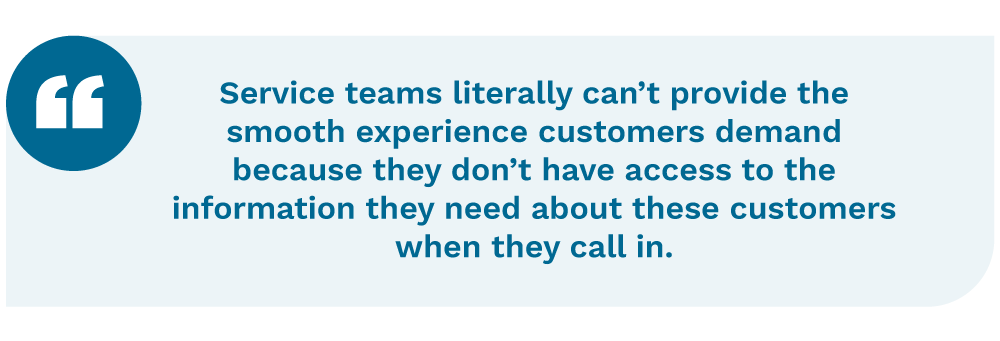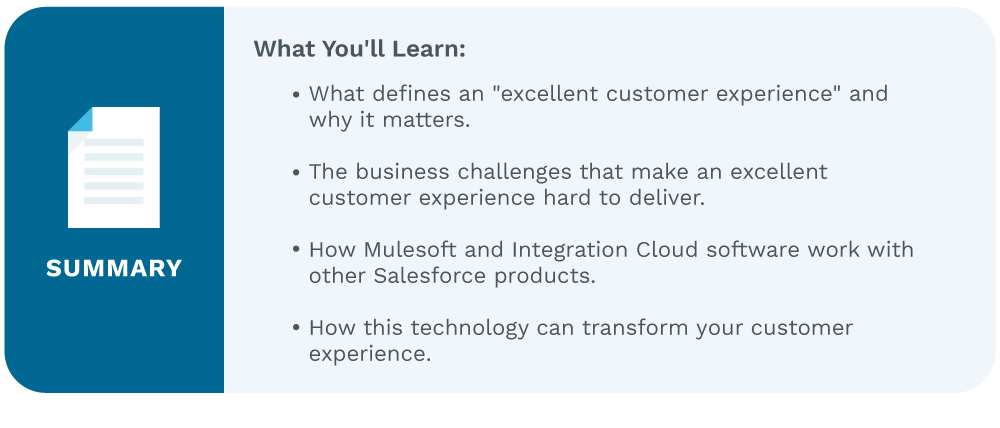
According to Bain & Company, businesses with excellent customer experiences grow their revenue at rates 4 to 8 percent above the market. Think about that; they’re talking about growth rates. So put another way, the stat reads: “Companies that offer excellent customer experiences outpace their competition in revenue by 4 to 8 percent, on average.”
But it’s difficult to know what exactly an “excellent customer experience” is in this context — and how you build one as a business. For help here, we turned to McKinsey. Their “CEO Guide to Customer Experience” highlights three main steps required to transform your customer experience from a series of touchpoints to a seamless journey. They are:
1. Observing all of a customer’s touchpoints with you, to understand your interactions from their perspective.
2. Slowly reshaping these touchpoints into a coherent journey, with the help of digitized processes and even adjustments to your company’s culture.
3. Improving performance within this new journey over time, across the company.
Put simply, the key to excelling at customer experiences lies in using technology to both understand how your customers interact with your business and also transform those touchpoints to make them flow effortlessly together.
Survey data from multiple companies support these ideas:
- While Microsoft found that 66 percent of consumers have used 3 or more customer service channels (web, phone, social, etc.), Salesforce® notes that 75 percent of them expect consistent experiences across those channels. 73 percent of consumers said they’d be likely to switch brands if they don’t receive that consistent experience.
- Similarly, Salesforce’s research also found that 59 percent of customers say that tailored engagement based on past interactions is important to winning their business.
- Finally, 64% of consumers and 80% of business buyers reported that they expect real-time responses and interactions from companies they buy from.
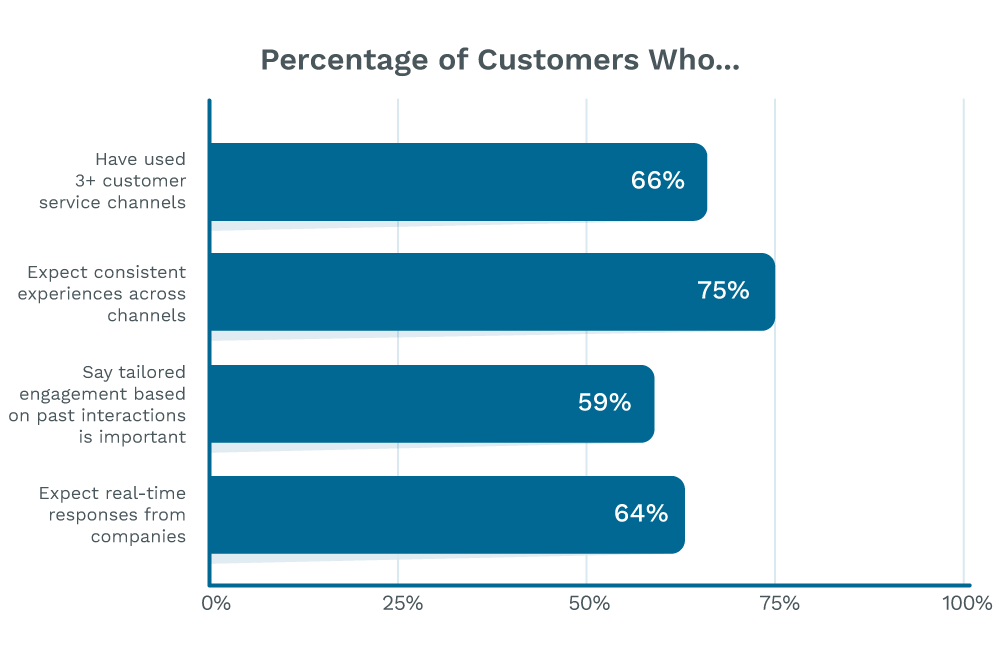 (Data Sources: Microsoft and Salesforce)
(Data Sources: Microsoft and Salesforce)
When you put all of that together, it shows that customer expectations of your service are high. Consumers are using more channels than ever to interact with your company, across departments (sales, service and more) and they expect consistent, individualized, real-time service no matter how they contact you. Delivering these personalized, meaningful interactions across all touchpoints will transform them into a consistent experience, where customers feel guided to the solution they need. Without this sort of personalization, they may feel tossed around from rep to rep until they end up at a destination they’re not comfortable with.
The Business Challenges That Make an Excellent Customer Experience Hard to Deliver
When most people think of excellent customer service, they might picture a mom-and-pop shop with a couple of dedicated employees that manage the entire customer base. With less clientele, it’s easier for these smaller shops to provide this kind of rich customer experience. Their reps can know each customer at a deeper level, and no matter how customers contact them (phone, email and so on) they’re likely to reach the same person.
It becomes much more difficult to maintain this level of service at scale, though. Once your company is big enough to need defined teams for customer-facing roles — marketing, sales, service and so on — the customer journey through your business begins to fracture. Some of this may be due to cultural misalignment or miscommunication between teams, but often the culprit is data. Service teams literally can’t provide the smooth experience customers demand because they don’t have access to the information they need about these customers when they call in.
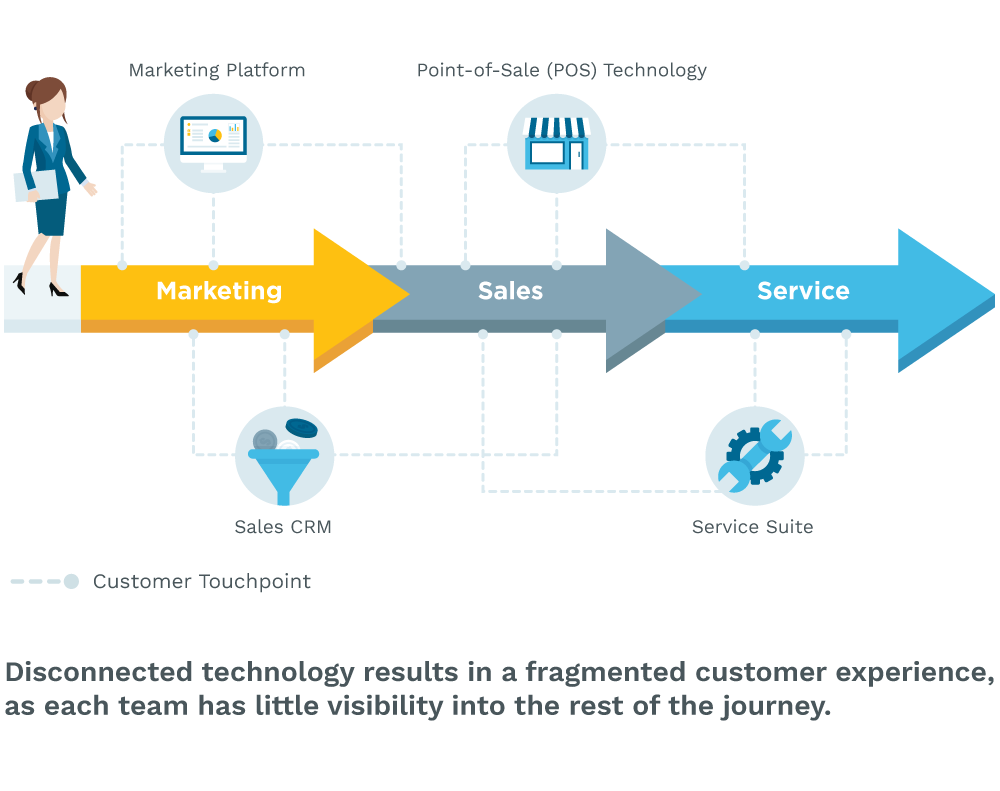 That’s where technology comes in. Remember the second step of McKinsey’s recommended approach to creating an excellent customer experience? It involves reshaping your disconnected customer touchpoints into a unified journey using digitized processes. Many companies possess the data they need to provide world-class customer service. The issue? It’s spread across multiple systems: Their CRM, ERP, point-of-sale (POS) technology, customer service suite, you name it. These companies’ teams don’t have a unified view of the customer, which prevents them from providing quick, personalized service to anyone, on any channel, across the board.
That’s where technology comes in. Remember the second step of McKinsey’s recommended approach to creating an excellent customer experience? It involves reshaping your disconnected customer touchpoints into a unified journey using digitized processes. Many companies possess the data they need to provide world-class customer service. The issue? It’s spread across multiple systems: Their CRM, ERP, point-of-sale (POS) technology, customer service suite, you name it. These companies’ teams don’t have a unified view of the customer, which prevents them from providing quick, personalized service to anyone, on any channel, across the board.
Salesforce and MulesoftTM: Creating Consistent Customer Experiences Through Integrated Data
If you’ve been to our blog before, you’ve probably heard us talk about Salesforce products as a means to solve issues like these. By pairing Service Cloud® solutions with the Sales Cloud® and Marketing CloudTM suites, your teams can leverage shared information and collaborate via consistent cross-team processes — all to the benefit of the customer experience.
But it’s unrealistic to assume that your business can run every part of your customer journey on the Salesforce platform. That’s what makes Salesforce’s acquisition of Mulesoft last year so crucial. With Mulesoft technology fueling Salesforce’s new Integration CloudTM platform, your company can connect data across disparate systems more easily than ever before. Here’s how it works.
{{cta('42ee0679-756e-4fb2-a9b3-19b3a78f429c')}}
How the Salesforce Integration Cloud solution works
Usually, any description of an integration tool would be highly complex and technical. Not so with the Integration Cloud platform (we do our best to keep these topics accessible, too). The product brings Salesforce’s “clicks-not-code” philosophy to the world of integrations, allowing you to automate complex cross-system workflows without a highly technical background.
The Mulesoft Anypoint Platform allows your teams to leverage pre-built connectors and ready-made integration templates to link your existing technology solutions. Need to bring purchase data from your POS technology into Salesforce? See how others have done it and use their best practices in your own integration design. With these plug-and-play elements, you can build your own solution on the shoulders of others instead of reinventing the wheel every single time.
The security and run-time features of the system are customizable to your needs as well. Build security features and protection policies into your APIs as you customize them, to make sure no outside hackers can use your connectors against you. Then, configure where your integration runs: on premises, on a private cloud, on a public cloud, you name it. You can even change where your integration flows run, to grant your organization a level of redundancy that can prevent costly downtime.
How the Integration Cloud platform works with other Salesforce products
As we’ve mentioned before on this blog, one core benefit of the Salesforce platform is its breadth. Its diverse portfolio of products not only offers a wide range of capabilities, but each one is designed to work seamlessly with the others. So, the more of them you use, the stronger each individual piece performs — much like, well, any movie you’ve ever seen about a team of superheroes.
The Integration Cloud solution is no different. Pairing it with Salesforce CRM functionality — whether you’re using Marketing Cloud journeys, Sales Cloud solutions or the Service Cloud suite — lets each customer-facing team improve their customer service. Marketers can leverage greater data access to better segment customers and deliver more personalized messages. Sales teams can use it to understand their clients at a deeper level and identify cross- and upsell opportunities within your existing customer base. Service teams, too, can take advantage of a customer’s complete data history to quickly respond to customer inquiries and complaints; it can even help them provide more proactive service.
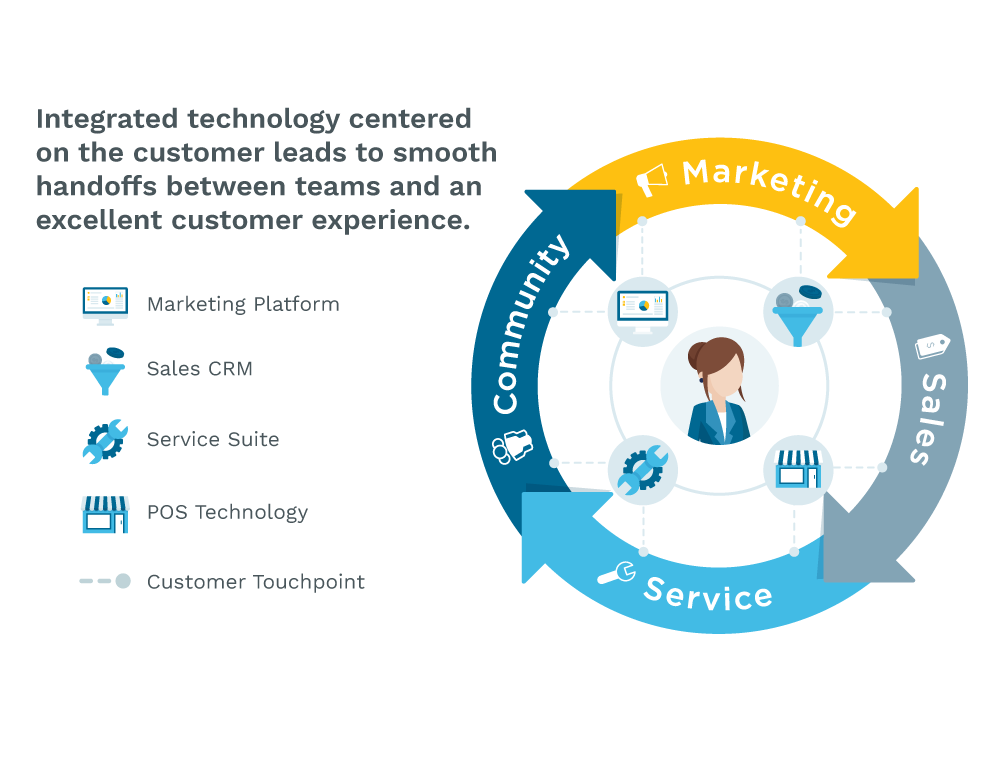 Meanwhile, the Salesforce Einstein Analytics platform may stand to gain the most from the addition of Integration Cloud. It makes sense, right? Artificial intelligence is only as good as the data it’s digesting. So, by that token, increasing the amount of data flowing through Salesforce — sourced from other systems such as an ERP, a POS solution or a billing system — can allow Einstein to better identify opportunities and threats in your world, be it customers you’re in danger of losing or high-value prospects likely to convert.
Meanwhile, the Salesforce Einstein Analytics platform may stand to gain the most from the addition of Integration Cloud. It makes sense, right? Artificial intelligence is only as good as the data it’s digesting. So, by that token, increasing the amount of data flowing through Salesforce — sourced from other systems such as an ERP, a POS solution or a billing system — can allow Einstein to better identify opportunities and threats in your world, be it customers you’re in danger of losing or high-value prospects likely to convert.
The last piece of the puzzle is coming soon to the Salesforce world. Its Customer 360 technology (slated for release later this year) will offer your teams an easy way to unify and deduplicate customer data. As demonstrated in the opening 2018 Dreamforce keynote, this solution pairs with Integration Cloud capabilities to deliver a complete view of every customer, across every one of your data systems. Of course, this sort of functionality is already available in existing Salesforce and Mulesoft offerings, but the Customer 360 release will allow you to manage this process much more seamlessly — no matter how you identify customers in your order data, customer service suite, POS system and more.
So What Can Integration Cloud Technology Do for Your Customer Experience?
At the end of the day, what does all of this mean for your business? Well, by pairing Salesforce and Mulesoft products, you can arm all of your customer-facing teams with the information they need to deliver world-class customer service. For example, when a customer calls your service desk, a support rep can quickly access every single interaction that person has had with your company: marketing engagements, purchase and order data, invoices and previous service cases. Every proverbial hand will know what the other is doing, resulting in a seamless journey for the customer, with value-add interactions at every step along the way.

Connected technology brings connected customer experiences. And, as we’ve seen from the statistics above, that kind of excellent service will ultimately pay dividends for your business.
Looking for more best practices about breaking down tech silos in your organization? Check out our on-demand webinar on how to handle your next integration like an expert. It’s packed with tips to help you get your disparate systems talking to each other, improving efficiency and collaboration across your business.

